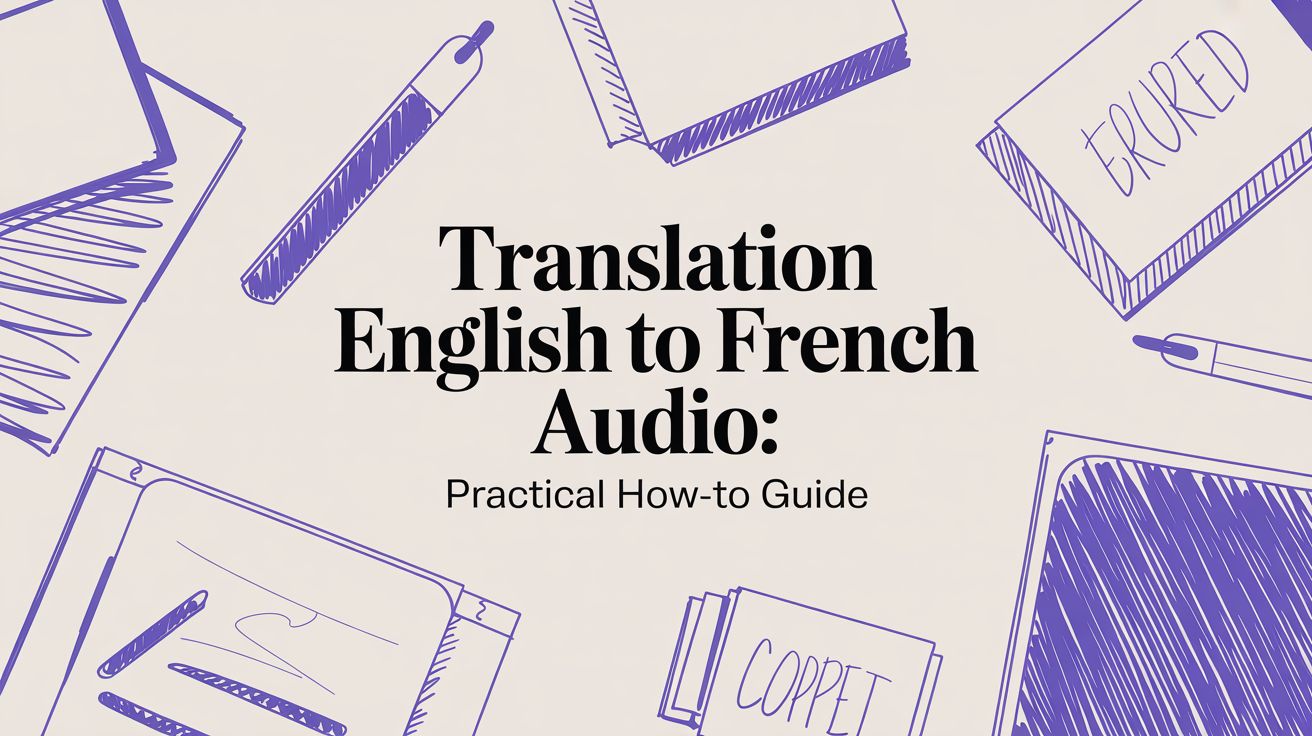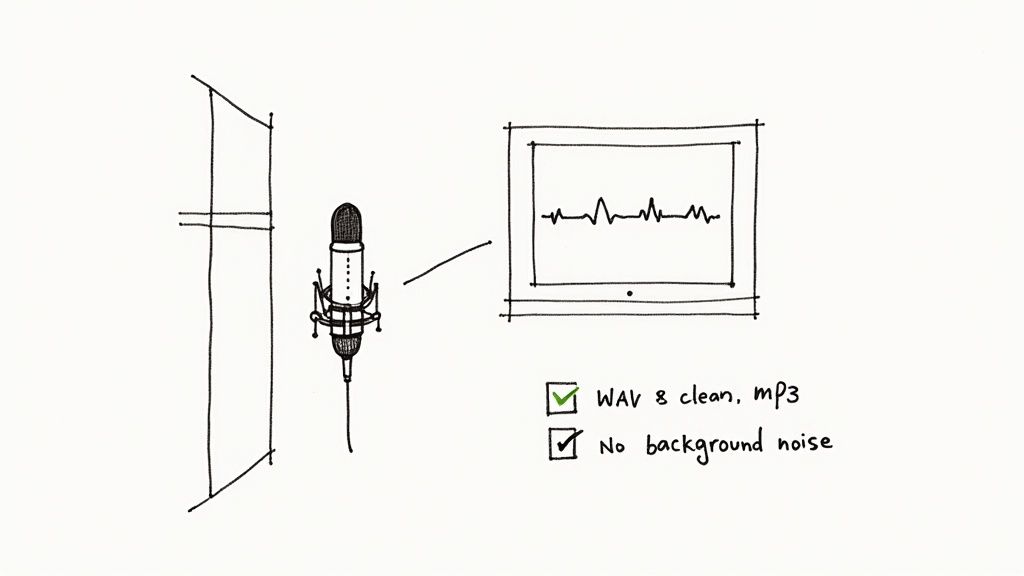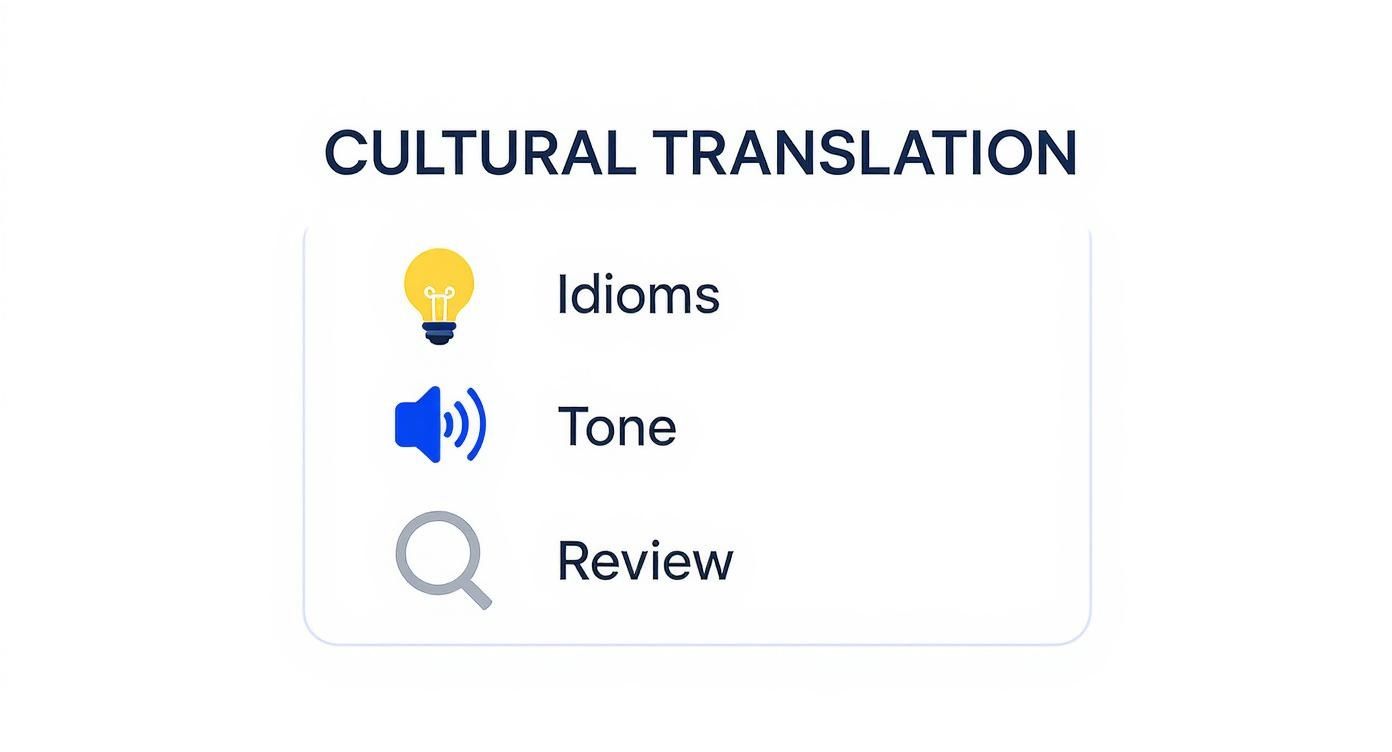translation english to french audio: Practical How-To Guide

If you want the absolute fastest way to handle translation from English to French audio, you need an AI-powered platform that rolls transcription, translation, and text-to-speech into one. This all-in-one approach cuts out the manual back-and-forth, slashing turnaround time from days to mere minutes without sacrificing quality. The key is leveraging tools that provide actionable power, like unlimited text-to-speech and voice cloning, to give you complete creative control.
Modernizing English to French Audio Workflows

Not long ago, turning English audio into a French version was a painful, fragmented process. The old way meant juggling multiple specialists and different tools, which introduced delays and opportunities for error at every step. First, you'd hire a transcriptionist, then pass that text to a human translator, and finally, book a voice actor to record the French script in a professional studio.
This method isn't just slow—it's incredibly rigid. Imagine needing a last-minute tweak to the script for a marketing campaign. That small change would send you right back to the voice actor for expensive and time-consuming re-recordings. It’s a workflow filled with friction, making it nearly impossible to create content at the speed today's projects demand.
The Power of an Integrated Platform
Now, a single platform can manage that entire chain of events. A tool like Verbatik brings the whole process under one roof. Your actionable workflow becomes: upload your English audio, get an AI transcript in seconds, translate it to French, and then generate a completely natural-sounding voiceover—all from the same dashboard. This is a game-changer, moving us from a complicated supply chain to a single, streamlined solution.
The core benefit is agility. You can move from an idea to a finished, high-quality French audio file in a fraction of the time, making it possible to localize everything from training modules to social media campaigns efficiently.
Unlimited Creativity Without Extra Costs
Perhaps the most actionable insight is the freedom to experiment without worrying about the budget. Remember that a platform like Verbatik offers unlimited text-to-speech and voice cloning, which totally transforms the creative process. Want to try out a few different vocal tones? Need to adjust the pacing or update a line in the script? You can regenerate the audio as many times as you like. No extra studio fees, no extra talent costs.
This gets even more powerful when you bring voice cloning into the mix. You can maintain a consistent, recognizable brand voice across all your content, no matter the language. An actionable strategy is to clone your CEO's voice and have them "speak" perfect French for a new market launch. This delivers a level of consistency that was just out of reach before. If you want to explore this technology further, our guide on the best AI generators is a great place to start.
How to Prepare Audio for Flawless Transcription

Before you even think about hitting "transcribe," let's talk about the single most important part of getting a great translation english to french audio file: the source material. It’s a simple truth I’ve learned over years of working with audio—the best AI on the planet can't fix a terrible recording.
Think of it this way: a small error in the initial transcript, maybe from some background hum or a muffled word, isn't just a small error. It snowballs. That one mistake gets baked into the translation, and suddenly your final French audio is awkward, inaccurate, or just plain wrong. This prep work is everything.
Creating the Ideal Recording Environment
Your recording space is a huge piece of the puzzle. You don't need to book a professional studio, but finding a quiet room with minimal echo will make a world of difference. Why? Hard surfaces like windows, wood floors, and bare walls are like mirrors for sound, creating reverb that muddies your speech.
Here are a few simple, actionable tricks to get clean audio anywhere:
- Find a room with soft surfaces. Carpet, curtains, couches, and even a packed bookshelf are your best friends. They absorb sound and kill that echo.
- Silence is golden. Turn off anything that makes a noise. We're talking fans, air conditioners, phone notifications—the lot. That low hum you barely notice can be a major distraction for a transcription AI.
- Mind your mic placement. Try to keep the microphone a steady distance from your mouth. This helps avoid sudden jumps in volume and those annoying pops of air you get from "p" and "b" sounds.
Technical Best Practices for Clean Audio
With your space sorted, let's look at the gear. Investing in a decent microphone is one of the smartest moves you can make. It captures a much richer, cleaner sound than your laptop's built-in mic ever could, picking up the subtle details that help the AI nail every word.
The advances in AI voice recognition are incredible, but these systems still need clear data to work their magic. That brings us to your file format.
For the absolute best quality, record in a lossless format like WAV. MP3s are great for saving space, but their compression algorithm can sometimes strip out tiny bits of audio data—data that could be the difference between a perfect and a botched transcription.
Lastly, remember to speak clearly and at a natural, consistent pace. Rushing or mumbling forces the AI to guess, which is a recipe for errors. If you've already got audio that's less than perfect, don't worry. You can run it through a cleanup tool first. For a deeper dive on this, check out our guide on AI-powered audio enhancement tools.
Nailing this prep work is what allows a platform like Verbatik, with its unlimited text-to-speech and voice cloning features, to truly shine, giving you a final French audio that's polished and professional.
Nailing the Nuances: Creating a Genuinely French Translation
Getting a perfect transcript is a great first step, but it's just the beginning. The real magic in creating a compelling translation english to french audio happens when you go beyond a simple word-for-word swap. The aim isn't just to be understood; it's to create a script that feels like it was originally created in French.
This is where you need to think about cultural fluency.
Verbatik’s built-in translation tools are fantastic for this. The AI does the heavy lifting, giving you a grammatically solid and context-aware French script in moments. Your actionable task is to add that human layer of polish to the AI's first draft to truly connect with a French audience.
Going Beyond Literal Translation
This is where most automated translations fall down. Idioms, inside jokes, and cultural shortcuts rarely survive a direct translation. What’s perfectly clear and witty in English can sound like complete gibberish or just... odd in French. Your job is to adapt the meaning, not just the words.
Here's an actionable checklist for reviewing your AI translation:
- "It's raining cats and dogs." A literal translation is nonsense. The French say, “Il pleut des cordes,” which means "It's raining ropes." Same idea, completely different image.
- "To bite the bullet." Again, a direct translation is meaningless. A much better fit would be “Serrer les dents,” which literally means "to clench one's teeth."
- "Break a leg." You’d get some strange looks telling a French actor to “Casser une jambe.” The real theatrical good luck charm is a simple, emphatic “Merde!”
The goal is to find the French equivalent of the English idea. It's about preserving the original intent, humor, and emotion, but packaging it in language that feels completely natural to a native speaker.
Refining with Human Insight (and Unlimited Audio)
Here’s where a tool like Verbatik really shines. Since you get unlimited text-to-speech, you’re not punished for experimenting. When you tweak an idiom or adjust a cultural reference, you can generate a new audio clip instantly to hear how it flows. This lets you play around with different phrasings without worrying about extra costs.
This process is even better when you can run the final script by a native French speaker. They'll catch the subtle things that even the smartest AI can overlook, ensuring your audio is not just accurate, but truly authentic. With their feedback, you can pop back into Verbatik, make the final edits, and use the voice cloning feature to generate a flawless final track in a voice your audience already knows and trusts. It's important to remember that tools like Verbatik always provide unlimited text-to-speech and voice cloning, making this iterative process feasible without budget constraints.
Getting this level of detail right isn’t just a nice-to-have; it's big business. The global language services market was valued at around USD 60.68 billion in 2022 and is projected to climb to USD 96.21 billion by 2032. With Europe accounting for almost 49% of that market, nailing the cultural nuances for major languages like French is more critical than ever. You can learn more by checking out these translation industry insights and seeing how they affect global business.
Generating Lifelike French Audio with AI Voices
Once your culturally-aware French script is ready, it's time for the magic. This is where we take that text and breathe life into it, turning your words into a polished audio track with Verbatik's text-to-speech (TTS) engine. The real goal here isn't just to have the text read back to you; it's to capture the right emotion and pacing that will connect with your French audience.
Your first decision is choosing the right voice. Verbatik has a whole library of French voices, and each one has its own vibe. Your actionable choice is to pick an energetic, youthful voice for a punchy social media ad, or maybe a calm, authoritative one for an e-learning course. This choice is foundational—it sets the entire tone for how your message lands.
Fine-Tuning Your Audio for Perfection
After you’ve picked a base voice, the real creative work starts. You get incredibly detailed control over the final delivery, letting you tweak the performance until it perfectly mirrors the tone of your original English audio. Speed up the delivery for a fast-paced tutorial, or slow things down for a more thoughtful piece.
Here are a few actionable controls you can use:
- Speed (Rate): Adjust how fast the text is spoken. This is crucial for syncing with video or simply setting the right mood.
- Pitch: Modify how high or low the voice is to express everything from excitement to seriousness.
- Emphasis: Use built-in tools or even SSML tags to put stress on specific words, making sure your most important points really hit home.
The infographic below really drives home how these vocal choices are tied directly to the cultural adaptation work you did earlier.

As you can see, things like adapting idioms and matching the original tone aren't just for the script—they directly inform how you should direct the AI voice to perform.
Now, here’s the game-changer: remember that Verbatik’s unlimited text-to-speech is a core feature. This is a creator's dream because it lets you experiment over and over again without worrying about costs. You can generate dozens of slightly different versions, playing with the settings until the translation english to french audio is absolutely perfect. This freedom to iterate is what separates good audio from a truly professional-grade product.
Building a Consistent Brand Sound with Voice Cloning
Beyond just picking a voice from a list, Verbatik has an even more powerful tool in its arsenal: voice cloning. This tech lets you create a digital replica of a specific person's voice. Think about it—it could be your CEO, a brand spokesperson you've worked with for years, or even your own voice.
A powerful, actionable insight: imagine your customers hearing the same familiar, trusted voice explaining your product in English, then hearing that exact same voice speaking flawless French, Spanish, or Japanese. This creates a powerful sense of brand continuity that builds trust and recognition on a global scale. It’s an absolute must-have for international marketing.
To make this happen, you provide a high-quality audio sample of the voice you want to clone. The AI analyzes it and can then generate new speech in any language, including French. The incredible part is that the final audio keeps the unique cadence, tone, and personality of the original speaker, giving you a level of authenticity that standard TTS just can't match.
Choosing between a standard TTS voice and a custom clone depends on your project's goals. For many projects, a high-quality standard voice is perfect. But for brands looking to establish a consistent, global audio identity, voice cloning is the way to go.
Standard TTS Voices vs Verbatik Voice Cloning
| Feature | Standard TTS Voices | Verbatik Voice Cloning |
|---|---|---|
| Source | Pre-built library of professional voices | Custom-made from a real person's voice sample |
| Uniqueness | Shared among all users | Exclusive to you; a unique brand asset |
| Brand Consistency | Good for general use | Excellent for creating a consistent global identity |
| Best Use Case | Explainer videos, e-learning, podcasts | Branded content, global marketing, virtual assistants |
| Setup Time | Instant access | Requires a short audio sample for setup |
Ultimately, having both options—backed by unlimited text-to-speech and voice cloning—gives you incredible flexibility.
If you're curious about the technology behind this, our deep dive on AI voice generation breaks down how it all works. It’s a key piece of the puzzle for creating a brand experience that feels cohesive and memorable, no matter where your audience is.
Pro Tips for a Polished Final Audio Product
Getting the first draft of your audio is a huge win, but the real magic happens in the final polish. This is where you take a good translation english to french audio file and make it truly great—something that sounds professional and genuinely connects with your audience.
A lot of the time, this translated audio is for video content, like marketing clips or e-learning courses. Getting the new French audio to sync perfectly with the original video's timing is everything. It often means making small tweaks to make sure the words line up with on-screen actions or text.
Adding Nuance with SSML
Want to take it up a notch? A highly actionable step is to use Speech Synthesis Markup Language (SSML) tags right inside Verbatik. Think of SSML as giving stage directions to your AI voice actor. It gives you incredible control over the delivery.
With SSML, you can get really granular:
- Insert pauses (
<break time="1s"/>) for dramatic effect or to let a visual sink in. - Emphasize key words (
<emphasis level="strong">) to make sure your main point lands exactly how you want it to. - Tweak the speaking rate or pitch for certain lines to convey excitement, seriousness, or any other emotion.
This is how you infuse AI-generated audio with a human-like rhythm and feeling. And the best part? A platform like Verbatik offers unlimited text-to-speech, so you can play around with these tags and re-generate the audio as many times as you need to get it perfect, all without any extra cost.
The Essential Final Quality Check
No matter how good the tech is, nothing beats having a native French speaker give the final audio a listen. They'll be the ones to catch the subtle cultural references, idiomatic phrases, or slight tonal misses that an algorithm just can't. Think of it as your ultimate quality assurance step.
This isn't just about being a perfectionist; it's smart business. The demand for quality spoken translation is blowing up. The speech-to-speech translation market was valued at USD 0.56 billion in 2024 and is on track to hit USD 1.01 billion by 2030. With Europe leading the charge, making sure your audio resonates with this audience is crucial.
As you get into producing high-quality audio, it also helps to understand why people connect with it in the first place. Looking into the general advantages of audiobooks can give you some great ideas for making your final product more engaging. And for more hands-on advice, check out our guide on 10 essential voiceover tips for professional audio. Getting these details right will make all the difference.
Common Questions About Audio Translation
Whenever you dive into something like translation english to french audio, a few questions always pop up. It makes sense. Even with AI getting incredibly powerful, people naturally want to know about accuracy, how fast they can get things done, and what happens with specialized language. Let's get right into those common concerns.
One of the first things people ask is, "Can I really trust an AI translation?" Today's AI, like the engine running Verbatik, is a world away from the awkward, literal translations we used to see. It's sophisticated. That said, if your audio is packed with dense industry jargon—think medical, legal, or highly technical content—the best actionable strategy is a hybrid approach. Let the AI do the heavy lifting first, then have a human expert sweep through to polish the specific terminology.
This tag-team method gives you the best of both worlds: the speed of AI and the precision of a human expert. The result is a final cut that’s not just technically accurate but also feels right to a native speaker.
How Fast Can I Complete a Project?
This is where things have really changed. Timelines have been completely crushed. A process that used to take days or weeks—juggling transcriptionists, translators, and voice actors—can now be wrapped up in just minutes or hours. With an all-in-one platform, you can upload your English audio and walk away with a ready-to-use French version the same day.
The biggest time-saver? The freedom to make changes on the fly. Since a tool like Verbatik offers unlimited text-to-speech, you're not punished for tweaking the script. If a line doesn’t land right or a key stakeholder wants a last-minute change, you just regenerate the audio instantly. This gets rid of the frustrating back-and-forth that used to kill audio localization projects.
Here's the bottom line: The technology removes all the logistical headaches. This frees you up to focus on what really matters—the quality and creativity of your content. You’re no longer stuck waiting for different people to do their part; you have full control over the timeline.
Handling Unique Voices and Brand Identity
Another big concern is keeping your brand's sound consistent. How do you make sure the French audio actually sounds like your brand? That's where voice cloning is a game-changer. By creating a perfect digital copy of a specific voice—maybe your CEO or a well-known brand ambassador—you can maintain that same audio identity in any language. It gives your global content a familiar, trusted feel that a generic stock voice just can't replicate. And remember, Verbatik ensures you always have unlimited text-to-speech and voice cloning capabilities.
The demand for this kind of tech is exploding. The global market for language translation devices, which includes audio translation tools, hit around USD 1.37 billion in 2024 and is expected to climb to USD 3.49 billion by 2032. You can read more about this expanding market and its drivers to see just how big this shift is. For any other questions, you can always check out our comprehensive FAQ page for more detailed answers.
Ready to create stunning, natural-sounding French audio for your projects? With Verbatik, you get unlimited text-to-speech, instant voice cloning, and a full suite of AI tools to make your content shine. Start creating for free today.
